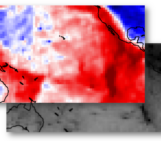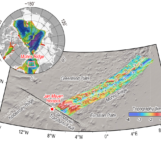
As we approach the Christmas break and the end of the year, what resonates with the concept of ‘holidays’ more than the Caribbean? In this week post, Angela Gomez-Garcia, postdoc at the Geoscience Institute of Barcelona, and Eline Le Breton, professor at Freie Universität Berlin, take us on a geodynamic journey through the Caribbean Large Igneous Plateau and its enigmatic connection with the Galápagos hot-spot.
Large Igneous Provinces (LIP) are magmatic units form during short igneous pulses, which significantly increase the thickness of the crust (Bryan and Ernst, 2008). The Caribbean LIP (C-LIP) was one of the first places where such thickened crust was identified in oceanic regions, along seismic reflection profiles, indicating a thicker-than-normal oceanic crust of up to ~20 km (Edgar et al.,1971; Donnelly, 1973).
Although several oceanic LIPs have been discovered since then, they represent one of the least understood magmatic processes on Earth. Nowadays, the C-LIP corresponds to the second largest plateau (by area) after the Ontong Java Plateau, with an approximated extent of 1.1×106 km2 and an estimated excess magma volume of 4.4×106 km3 (Kerr, 2014).
The origins of the Caribbean LIP
Oceanic LIPs are difficult to subduct due to the high buoyancy associated to their abnormal thickness and high temperatures inherited from their mantle plume origin. Thus, fragments of the C-LIP have been accreted along the continental margins of Ecuador, Colombia, Panama, Costa Rica, Curaçao, and Hispaniola (Hastie and Kerr, 2010; Thompson et al., 2004). Geochemical studies of these fragments (Geldmacher et al., 2003; Thompson et al., 2004; Kerr and Tarney, 2005; Hastie and Kerr, 2010) indicate that the C-LIP formed in the eastern Pacific, during rapid pulses of magmatic activity of the Galápagos hotspot, at ~ 91–88 and ~ 76 Ma (Sinton et al., 1998; Diebold and Driscoll, 1999). The melts of the plume head interacted with the Farallon (Proto-Caribbean) plate, creating the thicker-than-normal crust with several pulses of basalt flows and underplating (Diebold and Driscoll, 1999).
The evolution of the Caribbean plateau has provided relevant information for our understanding of modern plate tectonics. The C-LIP is the first example where clear evidence of plume-induced subduction initiation has been reported, as a consequence of the mantle flow patterns created by the plume, as well as by the strong rheological contrast between the incoming hot, large plume head and the Proto-Caribbean lithosphere (Whattam and Stern 2015; Baes et al., 2020). This discovery has long-lasting implications, as it suggests that plate tectonics, as we know it nowadays, may have started as a response of plume-induce subduction initiation around Precambrian plume heads (Whattam and Stern 2015).
What does 3D data-integrative lithospheric-scale models suggest about the present-day tectonic setting and the evidence of preserved plume conduits?
Plume-lithosphere interaction changes the configuration of the crust in several ways. Is it possible to retrieve some of the fingerprints of these plume-plate interactions in the present-day Caribbean lithosphere? We addressed this question by constructing a gravity-constrained 3D lithospheric-scale model of the Caribbean plate (Gómez-Garcia et al., 2021). This model was based on the integration of up-to-date global geophysical datasets from the Earth’s surface down to 200 km depth, which was validated using high-resolution free-air gravity measurements (Figure 1). We first found that the Colombian and the Venezuelan basins show thinner-than-normal oceanic crust (< 3 km; Figure 1a; Gómez-García et al., 2021). These areas partially correspond to the places where the basins reach their maximum depths (Figure 1b).
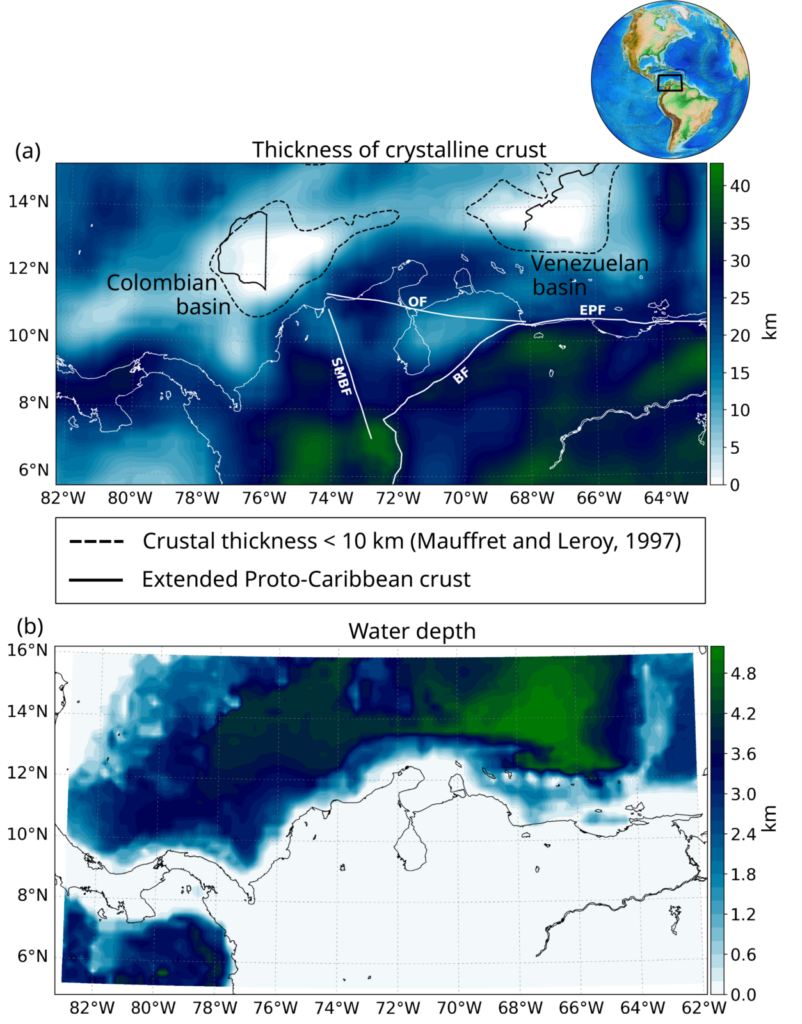
Figure 1. (a) Crystalline crustal thickness as compiled by Gómez-García et al. (2021). Extended Proto-Caribbean crust according to Bowland and Rosencrantz (1988) (Colombian basin) and Kroehler et al. (2011) (Venezuelan basin). BF = Boconó Fault. EPF = El Pilar Fault. OF = Oca Fault. SMBF = Santa Marta-Bucaramanga Fault. (b) Water depth from GEBCO (Weatherall et al., 2015). Modified from Gómez-García et al. (2021).
Our data-integrative approach included the S-wave tomography from the SL2013sv model (Schaeffer and Lebedev, 2013). In this dataset, it is possible to recognize the presence of two positive velocity anomalies down to 75 km depth (Video1). The forward modelling of the gravity field supports this trend, as two positive mantle density anomalies beneath the Colombian and the Venezuelan basins are required to fit the gravity observations, from the Moho down to 75 km depth.
We interpreted the high-density and high-velocity anomalies as preserved fossil plume conduits associated with the C-LIP formation, which migrated as the Proto-Caribbean lithosphere moved from the eastern Pacific towards its present-day location between North and South America. The interpreted plume conduits spatially correlate with the thin crustal regions present in both basins, indicating their potential connection with the centres of rapid uplift during the formation of the C-LIP in Late Jurassic–Early Cretaceous time.
Video 1. 3D reconstruction of the high-velocity and high-density bodies, interpreted as preserved plume conduits. Here, we assumed an S-wave velocity of 4540 ms–1 as the boundary of the high-density material (credit: Denis Anikiev and Ángela María Gómez-García).
Implications for the formation of the Caribbean lithosphere
Considering the arguments that we described before, we proposed an alternative to the commonly accepted tectonic model for the development of the Caribbean lithosphere, suggesting that the thin crustal domains (and not the thicker regions of the plate) in the Colombian and the Venezuelan basins correspond to the centres of uplift due to the inflow of the hot, buoyant plume head (Figure 2). Nonetheless, the lack of magmatic evidence that supports underplated material beneath these basins needs to be explained. If we take a closer look to the proposed evolution of the C-LIP (Figure 2), two possible explanations can be contemplated:
(1) The magmatism was broadly spread, but the uplifted portions of the C-LIP were eroded, as geological evidence suggests for this region (Buchs et al., 2018). Indeed, extreme erosion of other LIPs has been reported worldwide, where the preserved structure includes areas with no basalts in the centre of the plume head (Ernst et al., 2005).
(2) The location of the plume head had an offset relative to the basalt flows, and thus, the magma paths were preferentially concentrated along pre-existing lithospheric weakness zones (Buchan and Ernst, 2018; Ernst et al., 2019).
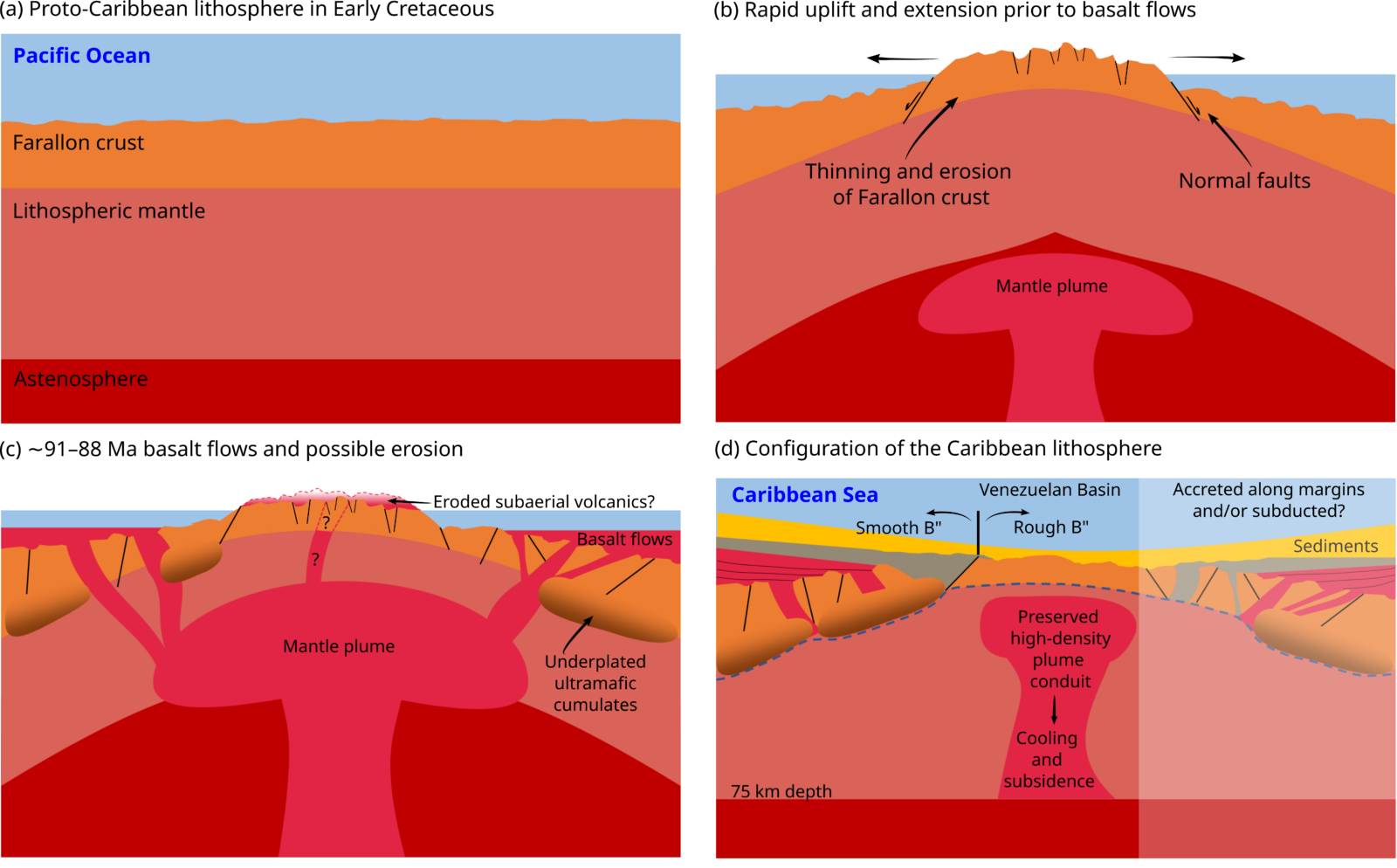
Figure 2. Cartoon illustrating the tectonic development of the Caribbean crust due to the interaction of the Farallon plate with a mantle plume. This cartoon is based on the tectonic model proposed by Driscoll and Diebold (1999) and on the present-day configuration of the Venezuelan Basin. Modified from Gómez-García et al. (2021). (a) Proto-Caribbean lithosphere in the Early Cretaceous with a normal crustal thickness. (b) Rapid uplift and thinning (extension) of the lithosphere due to the inflow of hot, buoyant plume material, prior to basalt flows. Erosion of the uppermost crustal structures was possible (e.g. Ernst, 2007, 2014). (c) c. 91-88 Ma basalt flows and possible erosion; additional magmatic pulse, extension and subsidence at c. 76 Ma. Subaerial erosion of the material spilled over the emerged portions of the crust is not disregarded (e.g. Buchs et al., 2018). Underplated ultramafic cumulates contributed to crustal thickening. Question marks indicate that the existence of magma conduits beneath the proposed centre(s) of uplift remains unclear. (d) The deepest Venezuelan and Colombian basins correlate with the most extended crustal domains, where the doming was probably more pronounced. Due to the north–north-eastward migration of the Proto-Caribbean plate, fragments of the C-LIP were subducted or accreted along the continental margins of the western South American plate.
Kinematic reconstructions of the Caribbean plateau: was the Galápagos hotspot responsible of the C-LIP formation?
To test the hypothesis if the C-LIP origin in the Galápagos hotspot, we used two recent regional kinematic reconstructions of the Caribbean plate (Boschmann et al. 2014 and Montes et al. 2019) with three different models of absolute plate motion (“subduction reference model” of Van der Meer et al., 2010; “Global Moving Hotspot model” of Doubrovine et al., 2012; and the most recent, geodynamically consistent “Optimized global reference model” of Müller et al., 2019) (Gómez-García et al. 2021). For these 6 different configurations, we obtained a misfit ranging from 1200 to 3000 km depending on the model used (Figure 3 and Table 1), between the location of the centre of the C-LIP at the time of plateau formation (90 Ma) and the present-day Galápagos hotspot location.
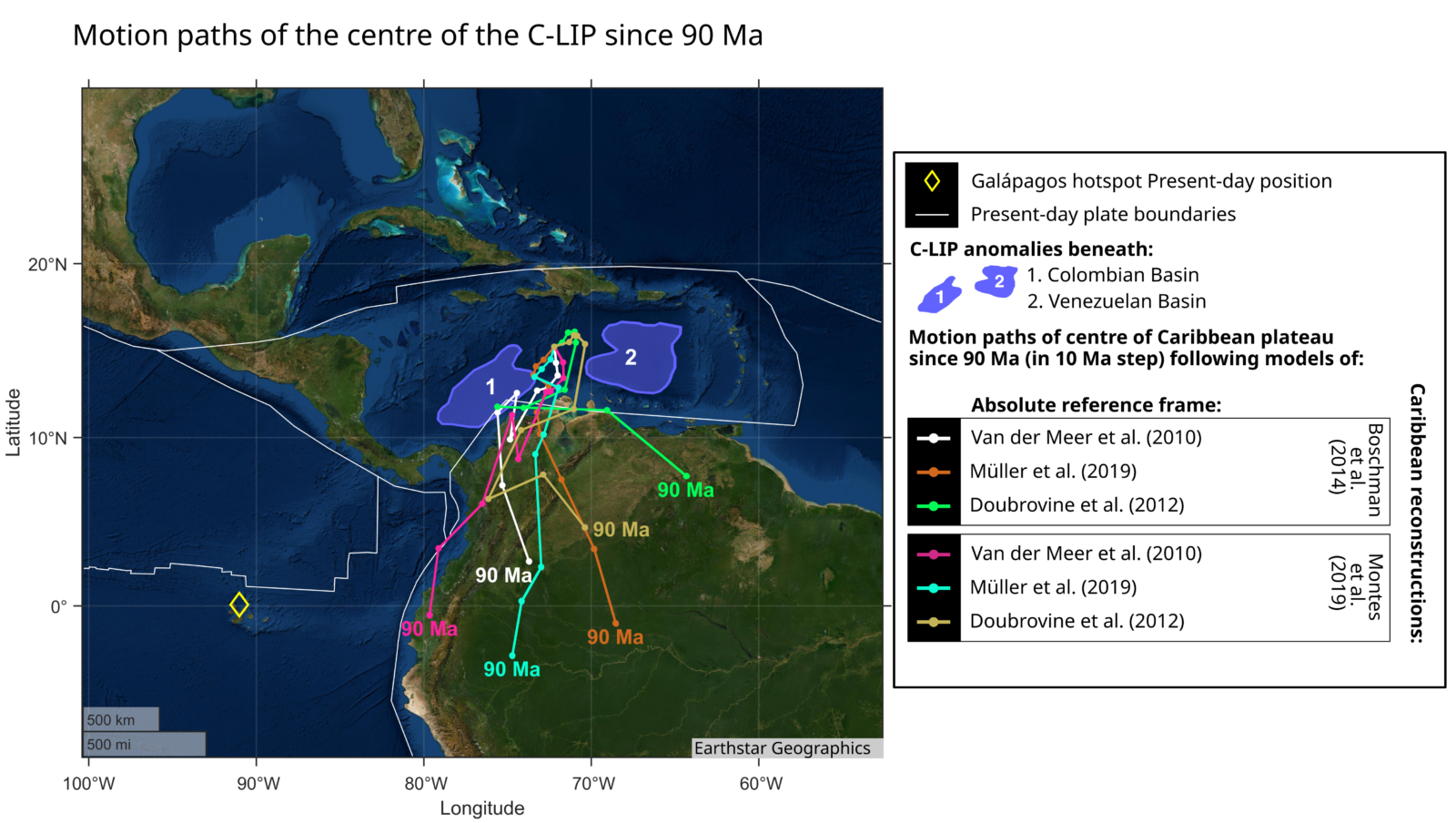
Figure 3. Kinematic reconstructions of the centre of the C-LIP back to 90 Ma show a significant offset with the present-day location of the Galápagos hotspot (motion paths in 10 Ma steps). Modified from Gómez-García et al. (2021).
This offset, also reported in previous studies (e.g. Pindell et al., 2006; Boschman et al., 2014), suggests that either:
- the paleo-Galápagos hotspot migrated significantly westwards (> 1000 km at about 1–2 cm/yr in a mantle reference frame) since the onset of the western Caribbean subduction, possibly due to a return flow away from the subduction zone (Steinberger and O’Connell, 2000), and had a large plume head during the C-LIP formation (> 2000 km in diameter);
or
- the C-LIP was formed by a different plume, which – if considered fixed – would be nowadays located below the north-western part of the South American continent (location of the motion paths at 90 Ma on Figure 3).

Table 1. Distance from C-LIP centre at 90 Ma to present-day Galápagos hotspot according to the different kinematic models tested by Gómez-García et al. (2021).
Nevertheless, the above-mentioned geochemical evidence supports the connection between the C-LIP and the Galápagos hotspot, favouring the first hypothesis of a possible westward migration of the paleo-Galápagos hotspot.
To continue unveiling the evolution of the intriguing, vast magmatic processes of the Caribbean LIP formation, future efforts should focus on:
- imaging with more detail the structure of the Caribbean lithosphere, for instance, with ocean bottom seismometer (OBS) campaigns,
- improving plate-tectonic reconstructions of the region, providing insights about the relation of the C-LIP with the probably moving Galápagos hotspot, and
- developing geodynamic models to test plume–lithosphere interactions, especially cooling and motion of plume conduits with the lithosphere.
For more information about this work, check our publication:
Gómez-García, Á. M., le Breton, E., Scheck-Wenderoth, M., Monsalve, G., and Anikiev, D.: The preserved plume of the Caribbean Large Igneous Plateau revealed by 3D data-integrative models. Solid Earth, 12(1), 275–298. https://doi.org/10.5194/se-12-275-2021, 2021.
References Baes, M., Sobolev, S. v., Gerya, T., and Brune, S.: Subduction initiation by plume-plateau interaction: Insights from numerical models. Geochemistry, Geophysics, Geosystems, 21(8). https://doi.org/10.1029/2020GC009119, 2020. Boschman, L. M., van Hinsbergen, D. J., Torsvik, T. H., Spakman, W., and Pindell, J. L.: Kinematic reconstruction of the Caribbean region since the Early Jurassic, Earth-Sci. Rev., 138, 102–136, https://doi.org/10.1016/j.earscirev.2014.08.007, 2014. Bowland, C. L. and Rosencrantz, E.: Upper crustal structure of the western Colombian Basin, Caribbean Sea, Geol. Soc. Am. Bull., 100, 534–546, https://doi.org/10.1130/0016-7606(1988)100<0534:UCSOTW>2.3.CO;2, 1988. Buchan, K. L. and Ernst, R. E.: A giant circumferential dyke swarm associated with the High Arctic Large Igneous Province (HALIP), Gondwana Res., 58, 39–57, https://doi.org/10.1016/j.gr.2018.02.006, 2018. Buchs, D. M., Kerr, A. C., Brims, J. C., Zapata-Villada, J. P., Correa-Restrepo, T., and Rodríguez, G.: Evidence for subaerial development of the Caribbean oceanic plateau in the Late Cretaceous and palaeo-environmental implications, Earth Planet. Sc. Lett., 499, 62–73, https://doi.org/10.1016/j.epsl.2018.07.020, 2018. Deng, Y., Zhang, Z., Mooney,W., Badal, J., Fan,W., and Zhong, Q.: Mantle origin of the Emeishan large igneous province (South China) from the analysis of residual gravity anomalies, Lithos, 204, 4–13, https://doi.org/10.1016/j.lithos.2014.02.008, 2014. Diebold, J., and Driscoll, N.: Chapter 19 New insights on the formation of the Caribbean basalt province revealed by multichannel seismic images of volcanic structures in the Venezuelan basin. Sedimentary Basins of the World, 4(C). https://doi.org/10.1016/S1874-5997(99)80053-7, 1999. Donnelly, T. W.: Magnetic anomaly observations in the Eastern Caribbean Sea, Initial Reports Deep Sea Drill. Proj., 1023–1029, 1973. Doubrovine, P. V., Steinberger, B., and Torsvik, T. H.: Absolute plate motions in a reference frame defined by moving hot spots in the Pacific, Atlantic, and Indian oceans, J. Geophys. Res.-Sol.Ea., 117, B09101, https://doi.org/10.1029/2011JB009072, 2012. Edgar, T., Ewing, J., and Hennion, J.: Seismic refraction and reflection in Caribbean Sea, Am. Assoc. Petr. Geol. B., 55, 833–870, https://doi.org/10.1306/819a3c76-16c5-11d7-8645000102c1865d, 1971. Ernst, R. E.: Mafic-Ultramafic Large Igneous Provinces (LIPs): Importance of the Pre-Mesozoic record, Episodes, 30, 108–114, https://doi.org/10.18814/epiiugs/2007/v30i2/005, 2007. Ernst, R. E.: Large Igneous Provinces, Cambridge University Press, Cambridge, https://doi.org/10.1017/CBO9781139025300, 2014. Ernst, R. E., Buchan, K. L., and Campbell, I. H.: Frontiers in Large Igneous Province research, Lithos, 79, 271–297, https://doi.org/10.1016/j.lithos.2004.09.004, 2005. Ernst, R. E., Liikane, D. A., Jowitt, S. M., Buchan, K. L., and Blanchard, J. A.: A new plumbing system framework for mantle plume-related continental Large Igneous Provinces and their mafic-ultramafic intrusions, J. Volcanol. Geoth. Res., 384, 75–84, https://doi.org/10.1016/j.jvolgeores.2019.07.007, 2019. François, T., Koptev, A., Cloetingh, S., Burov, E., and Gerya, T.: Plume-lithosphere interactions in rifted margin tectonic settings: Inferences from thermo-mechanical modelling, Tectonophysics, 746, 138–154, https://doi.org/10.1016/j.tecto.2017.11.027, 2018. Geldmacher, J., Hanan, B. B., Blichert-Toft, J., Harpp, K., Hoernle, K., Hauff, F., Werner, R., and Kerr, A. C.: Hafnium isotopic variations in volcanic rocks from the Caribbean Large Igneous province and Galápagos hot spot tracks, Geochem. Geophy. Geosy., 4, 1–24, https://doi.org/10.1029/2002GC000477, 2003. Gómez-García, Á. M., le Breton, E., Scheck-Wenderoth, M., Monsalve, G., and Anikiev, D.: The preserved plume of the Caribbean Large Igneous Plateau revealed by 3D data-integrative models. Solid Earth, 12(1), 275–298. https://doi.org/10.5194/se-12-275-2021, 2021. Hastie, A. R. and Kerr, A. C.: Mantle plume or slab window?: Physical and geochemical constraints on the origin of the Caribbean oceanic plateau, Earth-Sci. Rev., 98, 283–293, https://doi.org/10.1016/j.earscirev.2009.11.001, 2010. He, B., Xu, Y. G., Chung, S. L., Xiao, L., and Wang, Y.: Sedimentary evidence for a rapid, kilometer-scale crustal doming prior to the eruption of the Emeishan flood basalts, Earth Planet. Sc. Lett., 213, 391–405, https://doi.org/10.1016/S0012-821X(03)00323-6, 2003. Kerr, A. C.: Oceanic Plateaus. In Treatise on Geochemistry: Second Edition (2nd ed., Vol. 4, pp. 631–667). Elsevier Ltd. https://doi.org/10.1016/B978-0-08-095975-7.00320-X, 2014. Kerr, A. and Tarney, J.: Tectonic evolution of the Caribbean and northwestern South America: The case for accretion of two Late Cretaceous oceanic plateaus, Geology, 33, 269–272, https://doi.org/10.1130/G21109.1, 2005. Kroehler, M. E., Mann, P., Escalona, A., and Christeson, G. L.: Late Cretaceous-Miocene diachronous onset of back thrusting along the South Caribbean deformed belt and its importance for understanding processes of arc collision and crustal growth, Tectonics, 30, TC6003, https://doi.org/10.1029/2011TC002918, 2011. Li, D., Yang, S., Chen, H., Cheng, X., Li, K., Jin, X., Li, Z., Li, Y., and Zou, S.: Late Carboniferous crustal uplift of the Tarim plate and its constraints on the evolution of the Early Permian Tarim Large Igneous Province, Lithos, 204, 36–46, https://doi.org/10.1016/j.lithos.2014.05.023, 2014. Montes, C., Rodriguez-Corcho, A. F., Bayona, G., Hoyos, N., Zapata, S., and Cardona, A.: Continental margin response to multiple arc-continent collisions: The northern Andes-Caribbean margin, Earth-Sci. Rev., 198, 102903, https://doi.org/10.1016/j.earscirev.2019.102903, 2019. Müller, R. D., Zahirovic, S., Williams, S. E., Cannon, J., Seton, M., Bower, D. J., Tetley, M. G., Heine, C., Le Breton, E., Liu, S., Russell, S. H. J., Yang, T., Leonard, J., and Gurnis, M.: A Global Plate Model Including Lithospheric Deformation Along Major Rifts and Orogens Since the Triassic, Tectonics, 38, 1884–1907, https://doi.org/10.1029/2018TC005462, 2019. Pindell, J., Kennan, L., Stanek, K. P., Maresch, W. V., and Draper, G.: Foundations of Gulf of Mexico and Caribbean evolution: Eight controversies resolved, Geol. Acta, 4, 303–341, https://doi.org/10.1144/SP328.1, 2006. Schaeffer, A. J. and Lebedev, S.: Global shear speed structure of the upper mantle and transition zone, Geophys. J. Int., 194, 417–449, https://doi.org/10.1093/gji/ggt095, 2013. Sinton, C. W., Duncan, R. A., Storey, M., Lewis, J., and Estrada, J. J.: An oceanic flood basalt province within the Caribbean plate. Earth and Planetary Science Letters, 155(3–4), 221–235. https://doi.org/10.1016/s0012-821x(97)00214-8, 1998. Steinberger, B. and O'Connell, R.J.: Effects of Mantle Flow on Hotspot Motion. In The History and Dynamics of Global Plate Motions (eds M.A. Richards, R.G. Gordon and R.D. Van Der Hilst). https://doi.org/10.1029/GM121p0377, 2000. Thompson, P. M. E., Kempton, P. D., White, R. V., Kerr, A. C., Tarney, J., Saunders, A. D., Fitton, J. G., and McBirney, A.: Hf-Nd isotope constraints on the origin of the Cretaceous Caribbean plateau and its relationship to the Galápagos plume, Earth Planet. Sc. Lett., 217, 59–75, https://doi.org/10.1016/S0012-821X(03)00542-9, 2004. Van Der Meer, D. G., Spakman, W., Van Hinsbergen, D. J. J., Amaru, M. L., and Torsvik, T. H.: Towards absolute plate motions constrained by lower-mantle slab remnants, Nat. Geosci., 3, 36–40, https://doi.org/10.1038/ngeo708, 2010. Weatherall, P., Marks, K. M., Jakobsson, M., Schmitt, T., Tani, S., Arndt, J. E., Rovere, M., Chayes, D., Ferrini, V., and Wigley, R.: A new digital bathymetric model of the world’s oceans, Earth Space Sci., 2, 331–345, https://doi.org/10.1002/2015EA000107, 2015. Whattam, S. A., and Stern, R. J.: Late Cretaceous plume-induced subduction initiation along the southern margin of the Caribbean and NW South America: The first documented example with implications for the onset of plate tectonics. Gondwana Research, 27(1), 38–63. https://doi.org/10.1016/j.gr.2014.07.011, 2015. Zhang, S. H., Zhao, Y., Ye, H., and Hu, G. H.: Early Neoproterozoic emplacement of the diabase sill swarms in the Liaodong Peninsula and pre-magmatic uplift of the southeastern North China Craton, Precambrian Res., 272, 203–225, https://doi.org/10.1016/j.precamres.2015.11.005, 2016.

